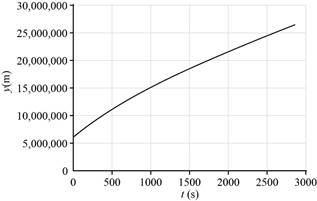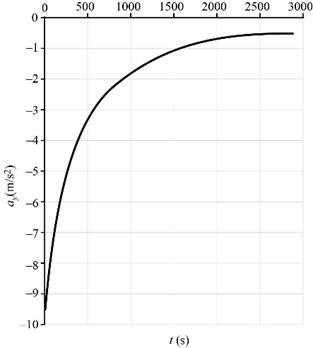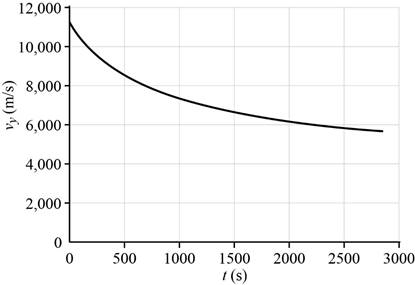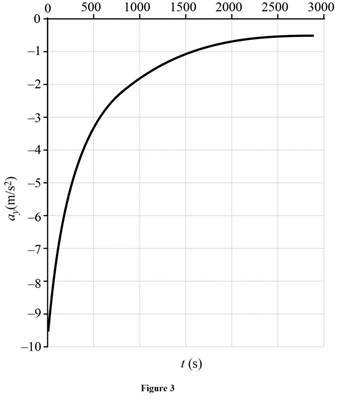
Concept explainers
In Example 2.6, we considered a simple model for a rocket launched from the surface of the Earth. A better expression for the rocket’s position measured from the center of the Earth is given by
where
a. Derive expressions for
b. Plot y(t), vy(t), and ay(t). (A spreadsheet program would be helpful.)
c. When will the rocket be at
d. What are
(a)
The expressions for
Answer to Problem 46PQ
The expression for
Explanation of Solution
Write the given expression for the position vector.
Here,
Velocity is the time derivative of position vector. Write the equation for velocity.
Here,
Acceleration is the time derivative of velocity. Write the expression for acceleration.
Here,
Conclusion:
Put equation (I) in equation (II).
Put equation (IV) in equation (III).
Therefore, the expression for
(b)
Plots of
Answer to Problem 46PQ
The plot of

The plot of

And the plot of

Explanation of Solution
The graph of position versus time of an object gives the position of the object at different instant of time. The slope of the position versus time graph gives the magnitude of the velocity of the object. In velocity versus time graph of an object, its velocity at different instants of time is plotted. The slope of this graph gives the magnitude of acceleration of the object. In acceleration versus time graph, acceleration is plotted as a function of time.
The plot of

The plot of

From the figure it is clear that the rocket has maximum velocity when it starts its motion and the velocity decreases with time. The graph has negative slope implying the acceleration is negative.
The plot of

From the figure, it is clear that the rocket has negative acceleration.
(c)
The time at which the rocket will be at
Answer to Problem 46PQ
The time at which the rocket will be at
Explanation of Solution
Equation (I) can be used to determine the time at which the rocket will be at
Substitute
Take the power
Conclusion:
Given that the radius of the Earth is
Substitute
Therefore, the time at which the rocket will be at
(d)
The value of
Answer to Problem 46PQ
The value of
Explanation of Solution
Equation (IV) can be used to determine the value of
Conclusion:
Substitute
Substitute
Therefore, the value of
Want to see more full solutions like this?
Chapter 2 Solutions
Bundle: Physics For Scientists And Engineers: Foundations And Connections, Volume 2, Loose-leaf Version + Webassign Printed Access Card For Katz's ... And Connections, Single-term Courses
- An unidentified flying object (UFO) is observed to travel a total distance of 23000 m, starting and ending at rest, over a duration of 2.59 s. Assuming the UFO accelerated at a constant rate to the midpoint of its journey and then decelerated at a constant rate the rest of the way, what was the magnitude of its acceleration? Express your answer in g s , where 1 g = 9.81 m/s^2. 699 g s 13,715 g s 6,857 g s 1,398 g sarrow_forwardThe velocity of a particle moving in the x-y plane is given by (6.98i + 6.68j) m/s at time t = 7.60 s. Its average acceleration during the next 0.014 s is (4.1i + 5.4j) m/s2. Determine the velocity v of the particle at t = 7.614 s and the angle θ between the average-acceleration vector and the velocity vector at t = 7.614 s.Answers:v = ( _____ i + _____ j) m/sθ = _____ °arrow_forwardA pirate has buried his treasure on an island with five trees located at the points (30.0 m, 20.0 m), (60.0 m, 80.0 m), (10.0 m, 10.0 m), (40.0 m, 30.0 m), and (70.0 m, 60.0 m), all measured relative to some origin, as shown in Figure P1.69. His ships log instructs you to start at tree A and move toward tree B, but to cover only one-half the distance between A and B. Then move toward tree C, covering one-third the distance between your current location and C. Next move toward tree D, covering one-fourth the distance between where you are and D. Finally move toward tree E, covering one-fifth the distance between you and E, stop, and dig. (a) Assume you have correctly determined the order in which the pirate labeled the trees as A, B, C, D, and E as shown in the figure. What are the coordinates of the point where his treasure is buried? (b) What If? What if you do not really know the way the pirate labeled the trees? What would happen to the answer if you rearranged the order of the trees, for instance, to B (30 m, 20 m), A (60 m, 80 m), E (10 m, 10 m), C (40 m, 30 m), and D (70 m, 60 m)? State reasoning to show that the answer does not depend on the order in which the trees are labeled. Figure 1.69arrow_forward
- The rectangle shown in Figure P3.56 has sides parallel to the x and y axes. The position vectors of two corners are = 10.0 m at 50.0 and = 12.0 m at 30.0. (a) Find the perimeter of the rectangle. (b) Find the magnitude and direction of the vector from the origin to the upper-right corner of the rectangle.arrow_forwardA hiker walks from (x1, y1) = (4.00 km. 3.00 km) to (x2, y2) = (3.00 km, 6.00 km), (a) What distance has the traveled? (b) The hiker desires to return to his starting point. In what direction should he go? (Give the angle with respect to due cast.) (See Sections 3.2 and 3.3.)arrow_forwardOlympus Mons on Mars is the largest volcano in the solar system, at a height of 25 km and with a radius of 312 km. If you are standing on the summit, with what Initial velocity would you have to fire a projectile from a cannon horizontally to clear the volcano and land on the surface of Mars? Note that Mars has an acceleration of gravity of 3.7m/s2 .arrow_forward
- In an assembly operation illustrated in Figure P3.30. a robot moves an object first straight upward and then also to the east, around an arc forming one-quarter of a circle of radius 4.80 cm that lies in an eastwest vertical plane. The robot then moves the object upward and to the north, through one-quarter of a circle of radius 3.70 cm that lies in a northsouth vertical plane. Find (a) the magnitude of the total displacement of the object and (b) the angle the total displacement makes with the vertical. Figure P3.30arrow_forwardIn an attempt to escape his island, Gilligan builds a raft and sets it to sea. The wind shifts a great deal during the day, and he is blown along the following straight lines:2.50 km 45.0º north of west; then 4.70 km 60.0º south of east; then 1.30 km 25.0º south of west; then 5.10 km straight east; then 1.70 km 5.00º east of north; then 7.20 km 55.0º south of west; and finally 2.80 km 10.0º north of east. What is his final position relative to the island? Be sure to include your vector drawing as part of your solution.arrow_forwardIn an attempt to escape his island, Gilligan builds a raft and sets to sea. The wind shifts a great deal during the day, and he is blown along the following straight lines: 2.50 km 45.0º north of west; then 4.70 km 60.0º south of east; then 1.30 km 25.0º south of west; then 5.10 km straight east; then 1.70 km 5.00º east of north; then 7.20 km 55.0º south of west; and finally 2.80 km 10.0º north of east. What is his final position relative to the island?arrow_forward
- You encounter a moving walkway that is 81 m long and has a speed of 2.1 m/s relative to the ground. How long would it take you to cover the 81 m length of the walkway if, once you get on the walkway, you immediately turn around and start walking in the opposite direction with a speed of 1.6 m/s relative to the walkway? Express your answer using one significant figure.arrow_forwardQ.4. A robot lands on Mars. Its x and y coordinates are given by equations:x(t) = 2m –(0.25m/s2)t2y(t)= (1.0 m/s)t +(0.025m/s3) (a).What is the position and distance from landing at t=2 seconds?(b)What is thedisplacement and average velocity during the interval from t=0 s to t= 2?(c).Derivea general expression for its instantaneous velocity vector and find its instantaneousvelocity in its component form as well as in terms of its magnitude.arrow_forwardA toy frog is initially at the origin of a Cartesian coordinate system. Upon leaping, its position after a second is given by P = (5.0 cm)i + (70 cm)) + (3.0 cm) k What is the distance (in centimeter) traveled by the toy frog assuming straight-line motion?arrow_forward
 College PhysicsPhysicsISBN:9781285737027Author:Raymond A. Serway, Chris VuillePublisher:Cengage Learning
College PhysicsPhysicsISBN:9781285737027Author:Raymond A. Serway, Chris VuillePublisher:Cengage Learning University Physics Volume 1PhysicsISBN:9781938168277Author:William Moebs, Samuel J. Ling, Jeff SannyPublisher:OpenStax - Rice University
University Physics Volume 1PhysicsISBN:9781938168277Author:William Moebs, Samuel J. Ling, Jeff SannyPublisher:OpenStax - Rice University Physics for Scientists and EngineersPhysicsISBN:9781337553278Author:Raymond A. Serway, John W. JewettPublisher:Cengage Learning
Physics for Scientists and EngineersPhysicsISBN:9781337553278Author:Raymond A. Serway, John W. JewettPublisher:Cengage Learning Physics for Scientists and Engineers with Modern ...PhysicsISBN:9781337553292Author:Raymond A. Serway, John W. JewettPublisher:Cengage Learning
Physics for Scientists and Engineers with Modern ...PhysicsISBN:9781337553292Author:Raymond A. Serway, John W. JewettPublisher:Cengage Learning Physics for Scientists and Engineers, Technology ...PhysicsISBN:9781305116399Author:Raymond A. Serway, John W. JewettPublisher:Cengage Learning
Physics for Scientists and Engineers, Technology ...PhysicsISBN:9781305116399Author:Raymond A. Serway, John W. JewettPublisher:Cengage Learning Principles of Physics: A Calculus-Based TextPhysicsISBN:9781133104261Author:Raymond A. Serway, John W. JewettPublisher:Cengage Learning
Principles of Physics: A Calculus-Based TextPhysicsISBN:9781133104261Author:Raymond A. Serway, John W. JewettPublisher:Cengage Learning





